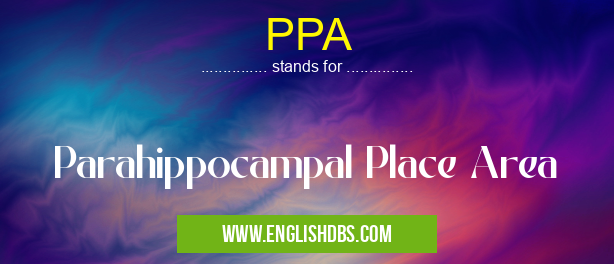What does PPA mean in UNCLASSIFIED
Parahippocampal Place Area (PPA) is a region of the brain located in the medial temporal lobe. It is involved in the processing of spatial information, particularly in relation to navigation and memory.

PPA meaning in Unclassified in Miscellaneous
PPA mostly used in an acronym Unclassified in Category Miscellaneous that means Parahippocampal Place Area
Shorthand: PPA,
Full Form: Parahippocampal Place Area
For more information of "Parahippocampal Place Area", see the section below.
Meaning of PPA
PPA stands for Parahippocampal Place Area. It is named after its location, which is adjacent to the parahippocampal gyrus, a region of the medial temporal lobe.
Functions of PPA
PPA is primarily involved in processing spatial information. It is thought to play a role in:
- Navigation: PPA is involved in the formation of cognitive maps, which are mental representations of the environment. This allows us to navigate our surroundings and plan routes.
- Memory: PPA is also involved in the retrieval of spatial memories. It helps us to remember the locations of objects and places, and to recall past experiences in specific locations.
Damage to PPA
Damage to PPA can lead to a number of spatial impairments, including:
- Topographical disorientation: Difficulty navigating familiar environments.
- Landmark amnesia: Inability to recognize or remember landmarks.
- Path amnesia: Difficulty recalling the route to familiar places.
Essential Questions and Answers on Parahippocampal Place Area in "MISCELLANEOUS»UNFILED"
What is the Parahippocampal Place Area (PPA)?
The Parahippocampal Place Area (PPA) is a brain region located in the medial temporal lobe that is involved in the processing of spatial information, particularly the representation of the locations of familiar places.
What are the main functions of the PPA?
The PPA plays a crucial role in recognizing and remembering the spatial layout of places, such as buildings, landmarks, and cities. It also helps in navigation and wayfinding, enabling us to mentally visualize and manipulate spatial environments.
How is the PPA involved in spatial memory?
The PPA is part of a network of brain regions that support spatial memory. It is involved in encoding, consolidating, and retrieving spatial information, allowing us to remember the locations of places we have visited or experienced.
What happens if the PPA is damaged?
Damage to the PPA can lead to a range of spatial memory impairments, including difficulty recognizing and navigating familiar places, as well as problems with wayfinding and spatial reasoning.
How is the PPA connected to other brain regions?
The PPA has strong connections with other brain regions involved in spatial processing, such as the hippocampus, retrosplenial cortex, and posterior parietal cortex. These connections allow for the integration of spatial information from different sources and support spatial cognition.
Final Words: The Parahippocampal Place Area (PPA) is a crucial region of the brain for spatial processing. It plays a role in navigation, memory, and the formation of cognitive maps. Damage to PPA can lead to a range of spatial impairments, highlighting its importance in our ability to interact with and navigate our environment.
PPA also stands for: |
|
| All stands for PPA |
